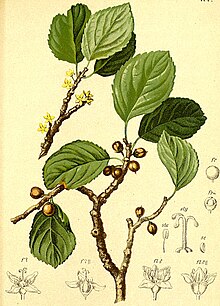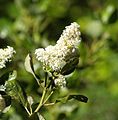Rhamnaceae
| Rhamnaceae Temporal range:
| |
|---|---|

| |
| Rhamnus pumila Turra | |
| Scientific classification | |
| Kingdom: | Plantae |
| Clade: | Tracheophytes |
| Clade: | Angiosperms |
| Clade: | Eudicots |
| Clade: | Rosids |
| Order: | Rosales |
| Family: | Rhamnaceae Juss. |
| Type genus | |
| Rhamnus | |
| Genera | |
|
See text | |

| |
| The range of Rhamnaceae. | |
| Synonyms | |
|
Frangulaceae DC. | |
The Rhamnaceae are a large family of flowering plants, mostly trees, shrubs, and some vines, commonly called the buckthorn family.[2] Rhamnaceae is included in the order Rosales.[3]
The family contains about 55 genera and 950 species.[4] The Rhamnaceae have a worldwide distribution, but are more common in the subtropical and tropical regions. The earliest fossil evidence of Rhamnaceae is from the Late Cretaceous. Fossil flowers have been collected from the Upper Cretaceous of Mexico and the Paleocene of Argentina.[5]
Leaves of family Rhamnaceae members are simple, i.e., the leaf blades are not divided into smaller leaflets.[2] Leaves can be either alternate or opposite. Stipules are present. These leaves are modified into spines in many genera, in some (e.g. Paliurus spina-christi and Colletia paradoxa) spectacularly so. Colletia stands out by having two axillary buds instead of one, one developing into a thorn, the other one into a shoot.




The flowers are radially symmetrical. There are 5 (sometimes 4) separate sepals and 5 (sometimes 4 or none) separate petals. The petals may be white, yellowish, greenish, pink or blue, and are small and inconspicuous in most genera, though in some (e.g. Ceanothus) the dense clusters of flowers are conspicuous. The 5 or 4 stamens are opposite the petals.[2] The ovary is mostly superior, with 2 or 3 ovules (or one by abortion).
The fruits are mostly berries, fleshy drupes, or nuts. Some are adapted to wind carriage, but most are dispersed by mammals and birds. Chinese jujube is the fruit of the jujube tree (Ziziphus jujuba) and is a major fruit in China.
The American genus Ceanothus, which has several showy ornamental species, has nitrogen-fixing root nodules.[6]
Economic uses of the Rhamnaceae are chiefly as ornamental plants and as the source of many brilliant green and yellow dyes. The wood of Rhamnus was also the most favoured species to make charcoal for use in gunpowder before the development of modern propellants.
-
Alphitonia ponderosa
-
Ceanothus
-
Ceanothus papillosus var. roweanus at the Regional Parks Botanic Garden, Berkeley, California
Genera
[edit]- Tribe Ampelozizipheae
- Ampelozizyphus Ducke
- Tribe Bathiorhamneae
- Bathiorhamnus Capuron
- Tribe Colletieae
- Adolphia Meisn.
- Colletia Comm. ex Juss.
- Discaria Hook.
- Kentrothamnus Suess. & Overkott
- Ochetophila Poepp. ex Reissek
- Retanilla (DC.) Brongn.
- Trevoa Miers ex Hook.
- Tribe Doerpfeldieae
- Doerpfeldia Urb.
- Tribe Gouanieae
- Alvimiantha Grey-Wilson
- Crumenaria Mart.
- Gouania Jacq.
- Helinus E.Mey. ex Endl.
- Johnstonalia Tortosa (originally named Johnstonia; by some treated as Gouania)
- Pleuranthodes Weberb. – synonym of Gouania
- Reissekia Endl.
- Tribe Maesopsideae
- Maesopsis Engl.
- Tribe Paliureae
- Condaliopsis (Weberb.) Suess.
- Hovenia Thunb.
- Paliurus Mill.
- Ziziphus Mill.
- Sarcomphalus P.Browne emend. Hauenschild
- Tribe Phyliceae
- Nesiota† Hook.f. Extinct (2003)
- Noltea Rchb.
- Phylica L.
- Trichocephalus Brogn.
- Tribe Pomaderreae
- Blackallia C.A.Gardner
- Cryptandra Sm.
- Papistylus Kellermann, Rye & K.R.Thiele
- Polianthion K.R.Thiele
- Pomaderris Labill.
- Serichonus K.R.Thiele
- Siegfriedia C.A.Gardner
- Spyridium Fenzl
- Stenanthemum Reissek
- Trymalium Fenzl
- Tribe Rhamneae
- Auerodendron Urb.
- Berchemia Neck. ex DC.
- Berchemiella Nakai
- Condalia Cav.
- Frangula Mill.
- Karwinskia Zucc.
- Krugiodendron Urb.
- Phyllogeiton (Weberb.) Herzog
- Pseudoziziphus Hauenschild[7]
- Reynosia Griseb.
- Rhamnella Miq.
- Rhamnidium Reissek
- Rhamnus L.
- Sageretia Brongn.
- Scutia (Comm. ex DC.) Brongn.
- Tribe Ventilagineae
- Incertae sedis
- Alphitonia Endl. (close to Colubrina)
- Araracuara Fern.Alonso
- Ceanothus L. (close to Pomaderreae)
- Chaydaia Pit. – synonym of Rhamnella
- Colubrina Rich. ex Brongn.
- Conalma G.L.Nesom
- Emmenosperma F.Muell. (close to Colubrina)
- Fenghwaia G.T.Wang & R.J.Wang
- Granitites Rye[8] (close to Alphitonia)
- Hybosperma Urb. – synonym of Colubrina
- Jaffrea H.C.Hopkins & Pillon
- Lasiodiscus Hook.f.
- Oreorhamnus Ridl.
- Schistocarpaea F.Muell.[9] (maybe belonging to Colletieae)
Systematics
[edit]Modern molecular phylogenetics recommend the following clade-based classification of Rhamnaceae:[10]
| |||||||
Fossil record
[edit]The fossil record of the family extends back to the Late Cretaceous, with records from Colombia[11] and Mexico.[12] Remains from the mid-Cretaceous Burmese amber of Myanmar have been suggested to belong to this family by some authors[13][14], but this has been doubted by others.[15] The earliest fossils of modern genera of the family date to the Eocene.[16]
References
[edit]- ^ "Family: Rhamnaceae Juss., nom. cons". Germplasm Resources Information Network. United States Department of Agriculture. 2003-01-17. Archived from the original on 2011-06-05. Retrieved 2011-01-29.
- ^ a b c Flowering Plants of the Santa Monica Mountains, Nancy Dale, 2nd Ed. 2000, p. 166
- ^ Walter S. Judd and Richard G. Olmstead (2004). "A survey of tricolpate (eudicot) phylogenetic relationships". American Journal of Botany. 91 (10): 1627–1644. doi:10.3732/ajb.91.10.1627. PMID 21652313.
- ^ Christenhusz MJ, Byng JW (2016). "The number of known plants species in the world and its annual increase". Phytotaxa. 261 (3): 201–217. doi:10.11646/phytotaxa.261.3.1.
- ^ Jud NA, Gandolfo MA, Iglesias A, Wilf P (2017-05-10). "Flowering after disaster: Early Danian buckthorn (Rhamnaceae) flowers and leaves from Patagonia". PLOS ONE. 12 (5): e0176164. Bibcode:2017PLoSO..1276164J. doi:10.1371/journal.pone.0176164. ISSN 1932-6203. PMC 5425202. PMID 28489895.
- ^ Kummerow J, Alexander JV, Neel JW, Fishbeck K (January 1978). "Symbiotic Nitrogen Fixation in Ceanothus Roots". American Journal of Botany. 65 (1): 63–69. doi:10.1002/j.1537-2197.1978.tb10836.x. JSTOR 2442555.
- ^ Hauenschild F, Matuszak S, Muellner-Riehl AN, Favre A (2016). "Phylogenetic relationships within the cosmopolitan buckthorn family (Rhamnaceae) support the resurrection of Sarcomphalus and the description of Pseudoziziphus gen. nov". Taxon. 65 (1): 47–64. doi:10.12705/651.4. JSTOR taxon.65.1.47.
- ^ "Granitites". FloraBase. Western Australian Government Department of Biodiversity, Conservation and Attractions.
- ^ "GRIN Genera of Rhamnaceae". Germplasm Resources Information Network. United. Archived from the original on 2015-09-24. Retrieved 2011-01-29.
- ^ Sun M, Naeem R, Su JX, Cao ZY, Burleigh JG, Soltis PS, Soltis DE, Chen ZD (2016). "Phylogeny of the Rosidae: A dense taxon sampling analysis". Journal of Systematics and Evolution. 54 (4): 363–391. doi:10.1111/jse.12211.
- ^ Correa E, Jaramillo C, Manchester S, Gutierrez M (January 2010). "A fruit and leaves of Rhamnaceous affinities from the late Cretaceous (Maastrichtian) of Colombia". American Journal of Botany. 97 (1): 71–79. doi:10.3732/ajb.0900093. ISSN 0002-9122. PMID 21622368.
- ^ Calvillo-Canadell L, Cevallos-Ferriz SR (October 2007). "Reproductive structures of Rhamnaceae from the Cerro del Pueblo (Late Cretaceous, Coahuila) and Coatzingo (Oligocene, Puebla) Formations, Mexico". American Journal of Botany. 94 (10): 1658–1669. doi:10.3732/ajb.94.10.1658. ISSN 0002-9122. PMID 21636362.
- ^ Shi C, Wang S, Cai Hh, Zhang Hr, Long Xx, Tihelka E, Song Wc, Feng Q, Jiang Rx, Cai Cy, Lombard N (2022-01-31). "Fire-prone Rhamnaceae with South African affinities in Cretaceous Myanmar amber". Nature Plants. 8 (2): 125–135. doi:10.1038/s41477-021-01091-w. ISSN 2055-0278. PMID 35102275. S2CID 246443363.
- ^ Oskolski AA, Morris BB, Severova EE, Sokoloff DD (2024). "Flowers from Myanmar amber confirm the Cretaceous age of Rhamnaceae but not of the extant genus Phylica". Nature Plants. 10 (2): 219–222. Bibcode:2024NatPl..10..219O. doi:10.1038/s41477-023-01591-x. PMID 38278949. S2CID 267267981.
- ^ Beurel S, Bachelier JB, Schmidt AR, Sadowski EM (2024). "Novel three-dimensional reconstructions of presumed Phylica (Rhamnaceae) from Cretaceous amber suggest Lauralean affinities". Nature Plants. 10 (2): 223–227. Bibcode:2024NatPl..10..223B. doi:10.1038/s41477-023-01592-w. PMID 38278948. S2CID 267267851.
- ^ Jud NA, Gandolfo MA, Iglesias A, Wilf P (2017-05-10). Wong WO (ed.). "Flowering after disaster: Early Danian buckthorn (Rhamnaceae) flowers and leaves from Patagonia". PLOS ONE. 12 (5): e0176164. Bibcode:2017PLoSO..1276164J. doi:10.1371/journal.pone.0176164. ISSN 1932-6203. PMC 5425202. PMID 28489895.
External links
[edit]- Rhamnaceae of Mongolia in FloraGREIF Archived 2016-03-04 at the Wayback Machine



